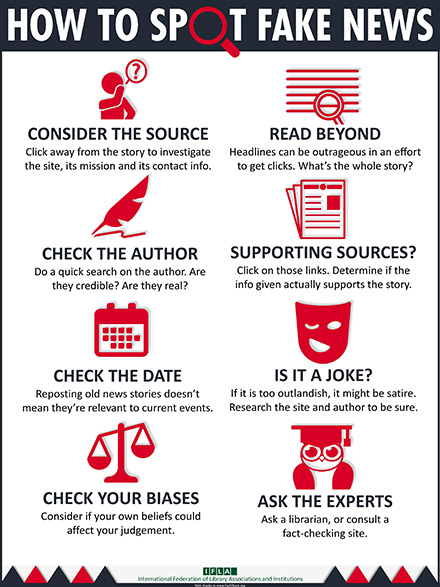Short video on how to spot fake news
1. Consider your source
- Who published the story? Real news is published by trustworthy news sources with a reputation for checking their facts.
- What claims does the news story make? Are these backed up by facts or evidence that you can double-check? If you can’t find any facts or evidence, take care – this might be a fake news story.
- Does the story include more than one point of view? Fake news stories often only present one side of the story.
- How does the story make you feel? If the story makes you feel angry or frightened, be careful. Fake news stories often use your emotions to try to influence what you believe.
- If you think a story might be fake news, then do more research. Ask more questions and find answers from another source.
2. Check the author
- Libguide Information LiteracyIn this Libguide are tips on evaluating an author.
3. Check the date
- Libguide Information LiteracySee the evaluation tips on currency in this Libguide
4. Check your biases
Bias is a tendency to believe that some people, ideas, etc., are better than others, which often results in treating some people unfairly.
Explicit bias refers to attitudes and beliefs (positive or negative) that we consciously or deliberately hold and express about a person or group.
Implicit bias includes attitudes and beliefs (positive or negative) about other people, ideas, issues, that we are not aware of ourselves and can't control but that are affecting our opinions and behavior.
Confirmation bias is our subconscious tendency to seek and interpret information in ways that affirm our existing beliefs, ideas and expectations. It mostly occurs around beliefs and ideas that we feel strongly about.
5. Read Beyond : Questionable contents of websites
These types of web pages may be legitimate but they should not be mistaken for impartial news sources:
Opinion pieces/editorials - these may be written by journalists or experts, but they should be clearly marked as opinion pieces and not mistaken for an impartial news report.
Native advertising or "sponsored content" - their purpose is to sell, not to inform. Wikipedia defines native advertising as "a type of advertising, mostly online, that matches the form and function of the platform upon which it appears. In many cases, it manifests as either an article or video, produced by an advertiser with the specific intent to promote a product, while matching the form and style which would otherwise be seen in the work of the platform's editorial staff."
Press releases - public relations pieces from a company or organization; they often are marked "For immediate release."
Publications by advocacy organizations or think tanks: organizations can produce useful materials but they should be understood to represent a particular point of view. It would be wise to seek other viewpoints for a more balanced understanding of the issues.
6. Supporting sources
Use various sources: see if the news has also been reported by other newspapers, television news, online articles.
7. Is it a Joke?
The purpose of satire or parody is to entertain and perhaps to persuade, but these kind of sources should not be mistaken for news sources. They obviously differ from intentionally misleading and deceptive fake news.
8. Ask the expert
Ask your Library Expert.
See the LibGuides to find the expert on your subject.
More tips
1. Go to the original source: e.g. if the story is a press release about a scientific item, read the original article the scientist has written about his research
2. Use various sources: see if the news has also been reported by other newspapers, television news, online articles
3. Check different viewpoints
4. Facts vs opinions: are the opinions given supported by facts?
5. Check the language. Be suspicious when you see:
- many typographical errors
- the use of words designed to upset or enrage
- many capital letters
- no links, quotes or references
Infographic IFLA
